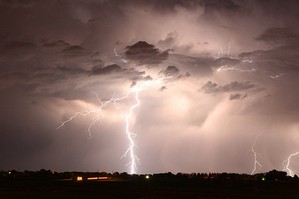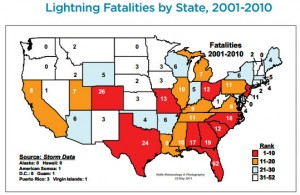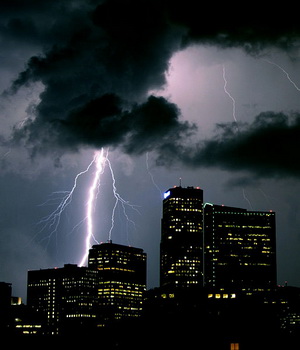
Of all the weather types associated with thunderstorms – hail, tornadoes, floods, etc – lightning is usually the most dangerous. In the United States there are an estimated 25 million cloud to ground lightning flashes each year and each one is a potential threat to life and property.
During the past 10 years there has been an annual average of 39 lightning fatalities in the United States. Last year, 23 people lost their lives due to lightning.
Colorado is ranked # 2 in lightning related deaths (2001 – 2010) so the danger this presents to life and property is very significant for us. It is interesting to note though that Colorado ranks only 32nd in the number of cloud to ground strikes over that same period. Which means, in short, we have fewer strikes than many other states and yet more deaths.
This highlights the fact that, quite frankly, folks here in Colorado are not aware of the dangers lightning presents and they do not take proper steps to protect themselves. One of the great things about Colorado are the outdoor activities we all enjoy, but there comes a time when we need to head indoors.

Since 1980, 91 people have been killed in Colorado by lightning and 434 people injured. On average, Colorado suffers three deaths and 13 injuries per year.
As thunderstorm season approaches, it is time to educate ourselves on the dangers of lightning.
Lightning Fast Facts
- If you can see it or hear it, lightning can hit you. Find shelter now.
- The primary rule for lightning safety: When Thunder Roars, Go Indoors!
- Lightning is the number two weather killer in the United States (behind floods), killing more than hurricanes and tornadoes combined.
- Lightning kills about 60 people in the U.S. each year and inflicts severe life-long debilitating injuries on at least a 1,000 people a year.
- Every 5 seconds between flash and boom is a mile’s distance from you.
- Under ideal conditions, lightning’s thunder can be heard 12 miles away.
- Lightning is really no wider than a few inches.
- “Bolts from the Blue” – These lightning flashes have been documented to travel more than 25 miles away from the thunderstorm cloud. Clear skies above you are no indication of how dangerous a nearby storm is!
- The air within a lightning strike can reach 50,000 degrees Fahrenheit.
- Lightning can heat its path five times hotter than the surface of the sun.
- One ground lightning stroke can generate between 100 million and 1 billion volts of electricity.
Lightning Safety Facts
- The “30-30 Rule” offers easy to follow lightning safety guidance. When you see lightning, count the time until you hear thunder. If that time is 30 seconds or less, the thunderstorm is close enough to be dangerous. Seek shelter. If you can’t see the lightning, just hearing the thunder is a good back-up rule. Wait at least 30 minutes after the lightning flash before leaving shelter.
- No place outside is safe during a thunderstorm!
- A house, or other fully enclosed building with wiring and plumbing offers your best protection against lightning. Once inside stay off of corded telephones, computers and other electrical appliances and stay away from sinks, showers, indoor pools and other plumbing. Don’t watch lightning from windows or doorways. Inner rooms are safer.
- A car with a metal roof and sides is your second best protection against lightning. As in a house, don’t touch any conducting paths leading outside. It is the metal shell that protects you, not the rubber tires.
- Lightning causes about $5 billion of economic impact in the U.S. each year!

What are the odds?
Here are some scary statistics to think about.
The odds of an individual being a lightning casualty (injured) in a year in the U.S. is about 280,000-to-1. If you’re an average person, in an average location, with average outside activities, and average lightning safety behavior. That’s about 3,000-to-one over your lifetime, with about 300-to-one odds of being seriously affected by a family member or friend being a lightning survivor.
The odds of an individual being killed by lightning each year in the U.S. is about 3 million-to-1, if you’re an average person, in an average location, with average outside activities, and average lightning safety behavior. That’s about 35,000-to-one over a life time, and about 3,000-to-one of being seriously affected by a family member or friend being killed by lightning.
Think about that. Three thousand to one odds that you yourself will be injured by lightning over your lifetime. That’s not very good odds at all. The next time you are outside and you see the telltale flash or hear the rumble, keep this in mind and please take appropriate precautions – the odds are against you if you don’t!
Colorado Lightning Injury Data – 1959-1995
|
LOCATION
|
NUMBER OF INJURIES
|
PERCENT
|
| OPEN FIELDS, BALL PARKS, AND OPEN SPACES |
130
|
40%
|
| UNDER TREES |
32
|
10%
|
| BOATING, FISHING, AND WATER RELATED |
20
|
6%
|
| NEAR TRACTORS OR HEAVY ROAD EQUIPMENT |
7
|
2%
|
| GOLF COURSES |
18
|
5%
|
| AT TELEPHONES |
6
|
2%
|
| VARIOUS UNKNOWN LOCATIONS |
115
|
35%
|
Colorado Lightning Deaths – 1959-1995
|
LOCATION
|
NUMBER OF DEATHS
|
PERCENT
|
| OPEN FIELDS, BALL PARKS, AND OPEN SPACES |
48
|
48%
|
| UNDER TREES |
19
|
19%
|
| BOATING, FISHING, AND WATER RELATED |
5
|
5%
|
| NEAR TRACTORS OR HEAVY ROAD EQUIPMENT |
3
|
3%
|
| GOLF COURSES |
7
|
7%
|
| AT TELEPHONES |
0
|
0%
|
| VARIOUS UNKNOWN LOCATIONS |
17
|
17%
|
Think about it!
National Weather Service Statement for Severe Weather Awareness Week
PUBLIC INFORMATION STATEMENT
NATIONAL WEATHER SERVICE GRAND JUNCTION CO
600 AM MDT FRI APR 15 2022
When Thunder Roars…Go Indoors.
Thunderstorms produce some of the most dangerous weather on earth including tornadoes, flash floods, large hail and destructive straight-line winds. However, the most dangerous aspect of thunderstorms in Colorado is usually lightning.
Lightning usually kills and injures more people in Colorado than any other thunderstorm hazard. From 1980 through 2016, lightning has killed 95 people and injured 472 people in Colorado.
In addition to producing human casualties…lightning also ignites most forest and rangeland fires in the Centennial State. Many of these wildfires occur when lightning is generated from thunderstorms which produce little or no rainfall. This type of lightning is commonly referred to as dry lightning.
The safest thing for you to do if you are outside and lightning or thunder begins to occur is to immediately get inside a substantial building…such as a house…a store or a church. A hard topped vehicle such as a car or truck also offer excellent protection from lightning. Once inside a substantial building or hard topped vehicle…keep all windows and doors closed and do not touch any metal inside the vehicle. It is then recommended that you wait at least 30 minutes from the last rumble of thunder before returning outside.
A recent lightning safety study has shown that 95 percent of the people who were struck by lightning while outdoors had a nearby substantial building or vehicle nearby. Remember…there is no safe place outdoors when lightning is occurring. Do not seek shelter under picnic shelters…dugouts…porches…trees…carports or tents. These types of structures are not safe when lightning is occurring.
Once inside a substantial building…stay off corded telephones and away from electrical appliances since the electrical discharge can travel along the telephone lines and electrical wires to produce fatal results. Stay away from water…such as showers…tubs and sinks. Even indoor swimming pools are not safe when lightning is occurring. It is also recommended that you unplug sensitive electronics such as computers when lightning is expected to occur nearby.
The best defense to protect yourself against a lightning strike is to plan ahead and avoid being caught where you might be vulnerable. Check the weather forecasts prior to venturing out, especially if you are heading into the mountains. Plan your outdoor activities for early in the day before thunderstorms typically develop. Stay tuned to NOAA All Hazards Weather Radio and check the National Weather Service forecasts at www.weather.gov.
It is very important that all sports leagues and other outdoor groups have a lightning response plan that is understood and consistently applied for the safety of the participants. Part of the plan would include a designated weather watcher at each outdoor event with the authority to postpone or cancel the event due to the threat of lightning.
Remember…if thunderstorms threaten, seek shelter in a substantial building or in an enclosed metal roof vehicle.
For more information on lightning safety, please check out the web site www.lightningsafety.noaa.gov.
For more information about lightning in Colorado, visit the Colorado lightning resource webpage at www.weather.gov/pub/ltg.php.
This is part five of a five part series on Colorado’s severe weather.
